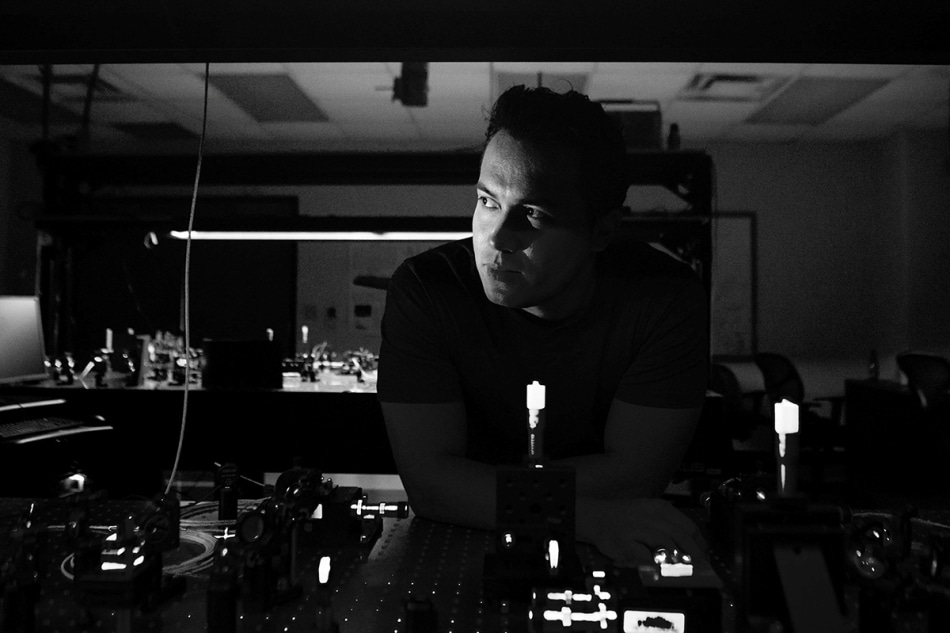Oct 1 2019
Omar Magaña-Loaiza, an assistant professor in the Department of Physics & Astronomy at Louisiana State University (LSU), and his research team have described a significant advancement in the quantum control and manipulation of light.
 Omar Magaña-Loaiza observes his efficient source of spontaneous parametric down-conversion. This source uses a nonlinear crystal to produce correlated photon pairs. (Image credit: Elsa Hahne/ORED)
Omar Magaña-Loaiza observes his efficient source of spontaneous parametric down-conversion. This source uses a nonlinear crystal to produce correlated photon pairs. (Image credit: Elsa Hahne/ORED)
The study, which has been recently reported in Nature’s NPJ Quantum Information, has extensive quantum technology applications in metrology, simulation, imaging, cryptography, communication, and computation.
The paper is titled “Multiphoton quantum-state engineering using conditional measurements.” It was contributed by co-authors from universities and institutes in Germany and Mexico and the National Institute of Standards and Technology in Boulder, Colorado. Chenglong You, a member of Dr Magaña-Loaiza’s experimental quantum photonics team and a postdoctoral researcher at LSU, is also a co-author of the study.
Light is difficult to control at the quantum scale, specifically for engineering purposes.
If we’re able to control photon fluctuations and associated noise, then we can make more precise measurements. This technology is new and will change our field.
Omar Magaña-Loaiza, Assistant Professor, Department of Physics & Astronomy, Louisiana State University
Globally, physicists are making major attempts to develop methods to sustain the quantum properties of light at sufficiently large scales for real-world purposes. To date, physicists can regulate the quantum characteristics of single photons as well as pairs of photons. This results in robust applications via entanglement as well as “heralding” (in which knowledge of a single photon offers comparatively specific knowledge about another photon that is yet to be detected).
Magaña-Loaiza’s group effectively illustrated a technique to produce groups of photons that have these same robust characteristics—referred to as multiphoton states.
When a few photons are subtracted out, “we can reshape the form of the wavepacket and artificially increase the number of photons in it,” added Magaña-Loaiza.
In addition, while previous researchers had created multiphoton states through various sources, Magaña-Loaiza’s research team was able to develop a single source to create multiphoton packets. These packets share resemblances with entangled lasers. This is indeed a significant technological breakthrough.
But perhaps, the most impressive fact revealed by the publication is that Magaña-Loaiza’s research team can produce various kinds of light, the quantum states of which can be manipulated in just one setup.
“I really think we’re doing something new, and I think people are starting to recognize this,” Magaña-Loaiza stated. Apart from producing single photons, the team can also generate entangled laser light as well as entangled natural light (that is, sunlight) with required characteristics.
If you’re able to manipulate light at this fundamental level, you can engineer light.
Omar Magaña-Loaiza, Assistant Professor, Department of Physics & Astronomy, Louisiana State University
In 2016, Magaña-Loaiza received his PhD in experimental quantum optics at the University of Rochester. He later became a research associate at the National Institute of Standards and Technology in Boulder, Colorado.
In August 2018, he joined the faculty at LSU and steers the experimental quantum photonics team. Achieving interesting advancements in quantum metrology, the team is developing multiple quantum technologies by using sources of entangled photons.
A paper titled “Multiphoton quantum metrology without pre- and post-selected measurements” was recently co-authored by Magaña-Loaiza and Dr You, when the latter was still a doctoral student. LSU physicist Jonathan Dowling and a number of collaborators have also contributed to the paper, which was recently chosen as a winner of the Emil Wolf Outstanding Student Paper Competition.